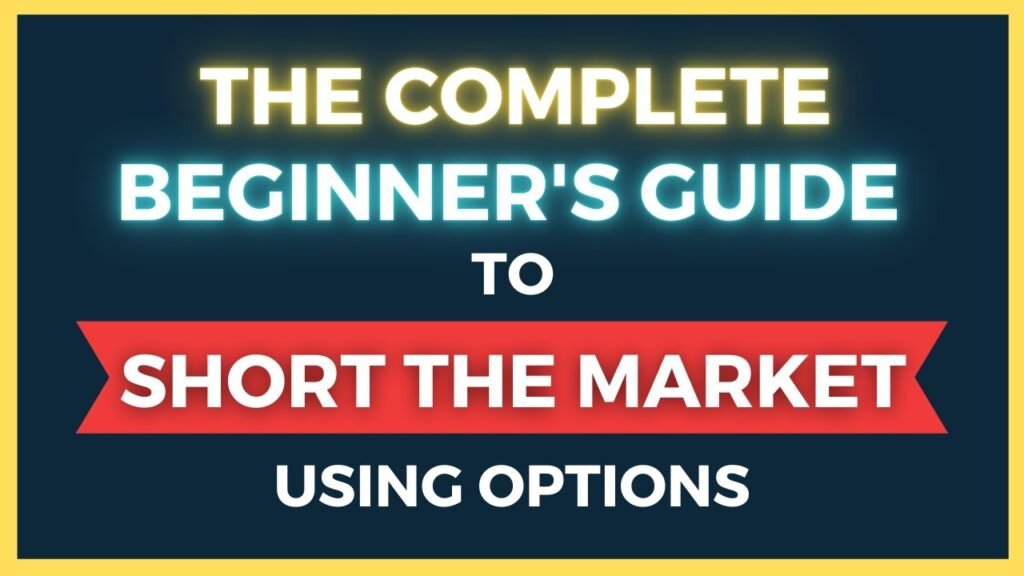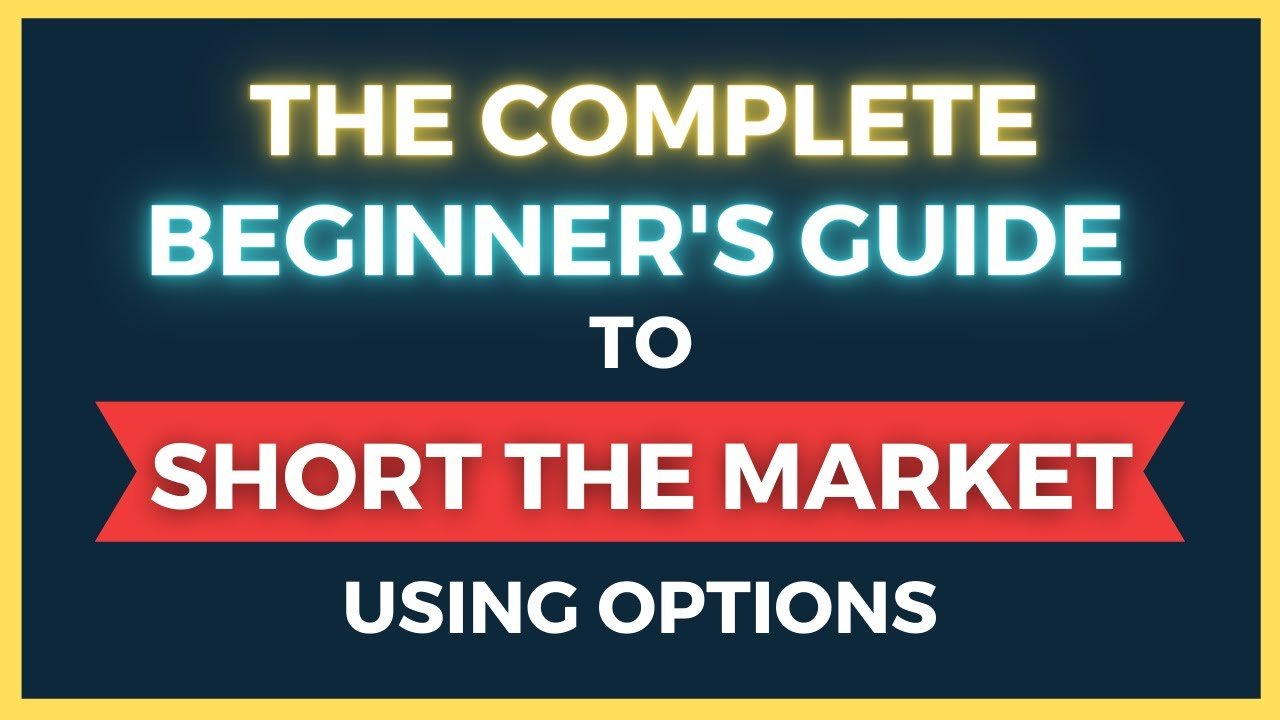In “The Complete Beginner’s Guide To Shorting The Market (Using Options)” video by Options with Davis, you’ll learn all about shorting the market and using options trading strategies. The video covers topics such as identifying high probability short opportunities, the best time to short the market, and the best option strategies to use. It also discusses other related videos on topics like the Wheel Strategy, Rolling Covered Calls, Stock Repair Strategy, and Credit Spreads. Throughout the video, viewers are encouraged to engage by giving a thumbs up, leaving comments, and asking questions. So if you’re interested in learning about credit spreads, bear put spreads, covered calls, and more, this video has got you covered!
In this video by Options with Davis, titled “The Complete Beginner’s Guide To Shorting The Market (Using Options)”, you’ll discover when and how to short the market using options trading strategies. From identifying high probability short opportunities to understanding the best time to short the market, this video provides valuable insights and tips. It also touches on concepts like market being overbought or oversold, using oscillators to identify market conditions, and looking at resistance areas as potential short trade opportunities. So if you’re a beginner looking to explore shorting the market, this video is a great resource for you!
Section 1: Understanding Shorting the Market
What is shorting the market?
Shorting the market is a trading strategy where an investor sells a security that they do not currently own, with the expectation that the price of the security will decline. This is done by borrowing the security from a broker and immediately selling it on the market, with the intention of buying it back at a lower price in the future to return it to the broker.
Why short the market?
Shorting the market can be a way for traders to profit from bearish market conditions or when they believe that a particular security is overvalued. It provides an opportunity to make money even when the market is declining, as traders can sell at a high price and buy back at a lower price.
Benefits and risks of shorting the market
Shorting the market has several benefits, including the ability to profit from declining markets, increased trading opportunities, and hedging potential. Shorting also allows investors to participate in various market conditions and take advantage of both up and down trends.
However, shorting the market also comes with risks. The main risk is that the price of the security being shorted may increase instead of decrease, resulting in losses for the trader. Additionally, shorting carries the potential for unlimited losses if the price of the security continues to rise significantly.
Section 2: Options Trading Strategies
Types of options trading strategies
Options trading strategies allow traders to take advantage of different market conditions and risk tolerances. There are various strategies available, including credit spread strategies and debit spread strategies.
Credit spread strategy
A credit spread strategy involves selling options with a higher premium and buying options with a lower premium on the same underlying security. This strategy allows traders to generate income by collecting the premium difference between the two options. It can be used when the trader believes that the price of the underlying security will not move significantly.
Debit spread strategy
A debit spread strategy involves buying options with a higher premium and selling options with a lower premium on the same underlying security. This strategy is used when the trader believes that the price of the underlying security will move significantly in a certain direction. It offers a better risk-to-reward ratio but has a lower probability of profit compared to credit spread strategies.
Section 3: Identifying Short Opportunities
Understanding market conditions
To identify short opportunities, it is important to have a good understanding of market conditions. This includes analyzing factors such as market trends, volatility, and overall market sentiment. By studying these conditions, traders can gain insight into potential shorting opportunities.
Using oscillators to identify market conditions
Oscillators, such as the Relative Strength Index (RSI) and the stochastic oscillator, can be helpful tools for identifying market conditions. These indicators measure the overbought and oversold levels of a security, providing traders with signals that the market may be due for a reversal. When the market is overbought, there is a higher probability of a price decline, making it an opportune time to consider shorting.
Identifying resistance areas
Resistance areas are price levels at which the market has historically struggled to move above. These areas can serve as potential opportunities for short trades, as they indicate selling pressure and the potential for the price to reverse and move lower. By identifying and monitoring these resistance areas, traders can increase their chances of finding profitable shorting opportunities.

Section 4: Using Options for Shorting
Selling covered calls
Selling covered calls is an options strategy that can be used for shorting the market. It involves owning the underlying security and selling call options against it. This strategy allows traders to collect premiums from selling the call options, providing a potential source of income. If the price of the underlying security declines, the trader can keep the premiums collected and still profit.
Covered call ratio spreads
A covered call ratio spread is another options strategy that can be used for shorting the market. This strategy involves selling a higher number of call options than the number of shares held, creating a net short position. It allows traders to collect more premiums while still benefiting from a price decline in the underlying security.
Bear call spreads
A bear call spread is a vertical options spread strategy that can be employed when a trader does not have a long-term investment position. It involves simultaneously selling a call option at a lower strike price and buying a call option at a higher strike price. This strategy allows traders to profit from a decline in the price of the underlying security while limiting potential losses.
Section 5: Choosing the Right Strategy
Risk-to-reward ratio versus probability of profit
When choosing an options strategy for shorting the market, traders need to consider their risk-to-reward ratio and the probability of profit. Credit spreads offer a better risk-to-reward ratio but have a lower probability of profit, while debit spreads have a higher probability of profit but a lower risk-to-reward ratio. Choosing the right strategy depends on the individual trader’s preference and risk tolerance.
Preemptive trades with credit spreads
Credit spreads can be used to make preemptive trades by initiating the trade before the market reaches a certain point. This allows traders to position themselves in anticipation of a potential downturn in the market, increasing their chances of profiting from a short trade.
Waiting for specific market levels with debit spreads
Debit spreads are more suitable for traders who prefer to wait for specific market levels before entering a trade. By waiting for the market to reach a certain level, traders can increase their probability of profit and potentially achieve a more favorable risk-to-reward ratio.
Section 6: Analyzing Market Conditions
Identifying resistance areas
As mentioned earlier, resistance areas are price levels that the market has struggled to break above. These areas can be identified by studying historical price data and chart patterns. By identifying these resistance areas, traders can monitor them for potential shorting opportunities and make informed trading decisions.
Using stochastics to determine market conditions
Stochastic oscillators are technical indicators that measure momentum and overbought/oversold conditions. They can be used to determine market conditions and identify potential shorting opportunities. When the stochastic oscillator indicates that a security is overbought, it suggests that the market may be due for a downward move, making it a favorable time to consider shorting.
Extended market movement and credit spreads
Extended market movement refers to a significant move in the market in one direction. When the market experiences an extended move, it increases the probability of a retracement or reversal. This presents an opportunity for traders to profit from short trades using credit spreads, as the market is more likely to reverse its trend after an extended movement.
Section 7: Setting Profit Expectations
Aim for positive expectancy
When shorting the market, it is important to have a long-term perspective and aim for positive expectancy. This means that over a series of trades, the trader expects to make more profits than losses. By maintaining a disciplined approach and following a well-thought-out trading strategy, traders can increase their chances of achieving long-term profitability.
Acknowledging losing trades
Losing trades are an inevitable part of trading, and it is important for traders to acknowledge and accept them. It is essential to have a risk management strategy in place to limit losses and protect capital. By focusing on the long-term profitability of their trading strategy, traders can overcome the emotional impact of losing trades and continue to be successful.
Long-term profitability
The ultimate goal of shorting the market is to achieve long-term profitability. This requires a combination of sound trading strategies, proper risk management, and continuous learning and adaptation. Traders should strive to continuously improve their skills and stay updated with market trends to maximize their chances of long-term success.
Section 8: Related Options Trading Strategies
The Wheel Strategy
The Wheel Strategy is an options trading strategy that involves selling cash-secured puts and covered calls on a particular stock. This strategy allows traders to potentially profit from both bullish and bearish market conditions by capturing premiums from options trades.
Rolling Covered Calls
Rolling covered calls is a strategy where traders roll their covered call positions to a future expiration date or a different strike price. This strategy can be used to manage and potentially enhance profits on covered call positions.
Stock Repair Strategy
The Stock Repair Strategy is an options trading strategy that can be utilized when a trader holds a long stock position that has significantly declined in value. This strategy involves selling call options against the stock to collect premiums and potentially recover some of the losses.
Section 9: Engagement and Questions
Thumbs up and leave comments
If you found this article helpful or informative, please give it a thumbs up and leave a comment! Your feedback is valuable and encourages the creation of more content like this.
Ask questions for clarification
If you have any questions or need further clarification on any of the topics discussed in this article, feel free to ask! The goal is to provide helpful information and support in your journey to understanding and implementing options trading strategies.
Section 10: Conclusion
Summary of shorting the market with options
Shorting the market with options can be a profitable strategy when executed correctly. By understanding market conditions, utilizing options trading strategies, and analyzing market trends, traders can identify shorting opportunities and increase their chances of success.
Subscribe and hit the notification bell for more videos
If you enjoyed this article and found it valuable, consider subscribing to Options with Davis for more educational content on options trading strategies. Hit the notification bell to stay updated and be notified when new videos are released. Happy trading!
